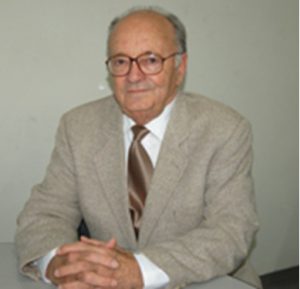 |
FULL PROFESSOR – DEPARTMENT OF PHYSYOLOGY IN THE SCHOOL OF MEDICINE OF RIBEIRÃO Preto – USP.
Even before graduation in Medicine (1959), he opted for the experimental work in Physiology under the guidance of Prof. Miguel Rolando Covian, when he obtained the first results indicating the importance of the Central Nervous System (CNS) in the control of specific sodium intake. He obtained his PhD in 1962, Free-Docent in 1968, Associate Professor in 1968 and Full Professor position in 1981. After his PhD he spent two years (1964-1966) in the United States, where he worked under the supervision of Dr. Samuel M. McCann, one of the pioneers in the field of neuroendocrinology, at the University of Pennsylvania, Philadelphia.
Throughout his scientific career he made several contributions on the role of the CNS in the control of the hydromineral balance, with special emphasis on the neural pathways involved in this homeostatic regulation. It was the first to demonstrate the importance of the paraventricular and supraoptic nuclei in the control of the specific sodium intake (Am. J. Physiol., 1963, 205: 922-926). Subsequently, we evaluated the main neural pathways, synaptic neurotransmitters and the neuroendocrine mechanisms involved in mediating this response. In this sense it has been demonstrated that the control of sodium intake is complex and involves besides the hypothalamus, the olfactory bulb, septal area, subfornical organ and amygdaloid complex (In: “Neural Integration of Physiological Behavior, Edited by Mogenson, GJ and Calaresu, FR, University of Toronto Press, 1975, p.267-282).
The discovery of the existence of the atrial natriuretic peptide (ANP) receptors in the cellular body of hypothalamic neurons, in regions related to sodium intake / excretion control, led him to investigate the participation of this heart peptide in the control of hydroelectrolytic homeostasis. The osmotic, adrenergic, cholinergic and peptidergic stimulation of the hypothalamus induces the release of ANP. On the other hand, administration of ANP in restricted regions of the CNS inhibits water and sodium intake (Proc Natl Acad Sci USA, 1985, 82: 8720-8723 and Endocrinology 1986, 118: 1726-1728). On the other hand, the natriuresis induced by cholinergic stimulation is accompanied by a marked increase in plasma ANP concentration, associated with the elevation of its content in the hypothalamic ANPergic neuronal system, which suggests the activation of these neurons and their release into the systemic circulation (Proc. Natl Acad Sci USA 1989, 86: 9621-9625).
Release of ANP induced by extracellular volume expansion (EVEC) is blocked when the cell bodies or axons of this neural system are destroyed (Proc Natl Acad Sci USA, 1991, 88: 2956-2960). These results led him to conclude that the release of ANP induced by EVEC may be due to the release of neuropeptides from the hypothalamic-pituitary system such as: endothelin (ET-3), MSH, oxytocin, vasopressin and the ANP itself, which once released in the systemic circulation, would stimulate the release of ANP directly from atrial myocytes. Recently, it has been shown that sino-aortic and renal denervation decreases the release of ANP induced by EVEC (Proc. Natl. Acad Sci. USA, 1992, 89: 6828-6831), which highlights the importance of the CNS in its control.
At present, experiments are being conducted that try to demonstrate modifications in the gene expression of ANP, vasopressin and oxytocin in restricted areas of the CNS in response to saline imbalance. The activity of scientific orientation at the postgraduate level has been very fertile (~50 PhD), counting among its oriented several excellent teachers-researchers in the main Brazilian universities. It has about 357 articles published in indexed journals and has already guided several doctoral theses and master’s theses. (Citations = 6743; H index = 40).
Research Line:
• Neuroendocrine Control of Hydroelectrolytic Equilibrium;
• Neuroendocrine Control of Reproductive Physiology.
SOCIAL NETWORKS
